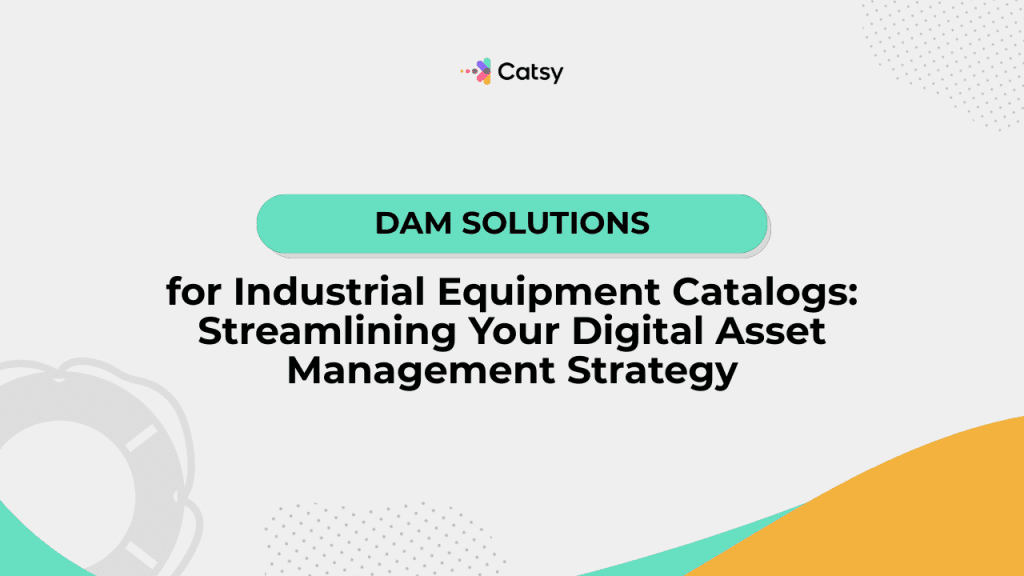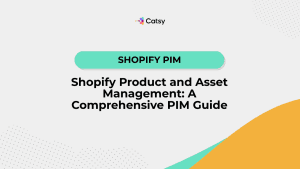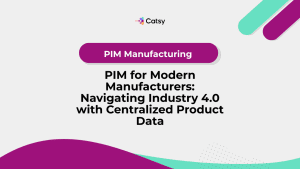DAM Solutions for Industrial Equipment Catalogs: Streamlining Your Digital Asset Management Strategy

Introduction
Imagine that your sales team is preparing for a major presentation to a prospective client. They need high-res images of a hydraulic pump, tech specs for three different valve models, and installation videos for a conveyor system.
Right now, these assets are scattered across printed catalogs, email chains, and former employees’ cloud drives.
Sound familiar? You’re not alone. But don’t worry! Your content doesn’t have to drift aimlessly.
Industrial equipment manufacturers face unique challenges. Vast libraries of images, multimedia content, and tech specs are difficult to manage!
DAM solutions for industrial equipment catalogs have emerged as the game-changing technology that transforms how companies organize, distribute, and leverage their digital assets. Now you can effectively captain your content with confidence.
In this guide, we’ll explore how Digital Asset Management (DAM) systems specifically address the complex needs of industrial equipment catalogs while keeping your content on course.
In this Article
Understanding DAM Solutions in the Industrial Context
What Makes Industrial Equipment Catalogs Unique?
Industrial equipment catalogs aren’t your typical product brochures. They’re complex repositories containing:
- Technical specifications with precise measurements and performance data
- High-resolution product images, including multiple angles
- Installation guides and manuals often totaling hundreds of pages
- Video demonstrations showing your equipment in action
- 3D models and CAD files for engineering teams
- Compliance documentation and safety certifications
- Multilingual versions for global markets
Traditional consumer products may have a handful of marketing images. A single piece of industrial equipment, on the other hand, could have hundreds of associated assets!
Consider a large industrial compressor. You might own installation videos, energy efficiency certifications, performance charts for different operating conditions, and maintenance schedules that vary by application. That’s just one product! You likely have thousands more in your catalog!
The Traditional Catalog Challenge
Before DAM systems, most industrial companies managed their catalogs through a patchwork of solutions:
- Shared network drives with inconsistent folder structures
- Email attachments that created version control nightmares
- Individual departmental databases that led to asset silos
- Print-focused workflows that didn’t translate well to digital channels
A fragmented approach like this can lead to real business problems. Outdated product information will reach customers, sales teams can’t find the correct assets, and marketing departments waste time re-creating content that already exists… you just don’t know where.
Real-World Example: A major industrial pump manufacturer discovered that they had 47 different versions of the same product datasheet scattered across their organization. Sales teams were sending conflicting technical specs to the same customer, nearly costing them a $2 million contract.
Make Catsy DAM and PIM Software an Extension of Your Team
Book a Free DemoCore Benefits of DAM Solutions for Industrial Equipment Catalogs
1. Centralized Asset Repository
The key to any effective DAM solution is to create a single source of truth for all your digital assets; this is your content command center. For industrial equipment catalogs, that means:
Unified Storage: All of your product images, technical documents, videos, and specifications live in one (searchable!) location.
Consistent Organization: Assets are tagged and categorized using industry-specific metadata that makes sense for your unique business.
Global Access: Your international team members have access to the same updated assets. This ensures consistency across each of your markets.
2. Advanced Search and Filtering Capabilities
An industrial equipment catalog may contain thousands of products across multiple categories. A DAM system provides a sophisticated search – it goes well beyond file name searches!
- Metadata-driven searches use product codes, specifications, or application types
- Visual similarity searches can find images of similar equipment
- Advanced filtering by product category, market segment, or asset type
- Saved search queries for frequently accessed asset collections
3. Version Control and Asset Lifecycle Management
Accuracy is of the utmost importance in the industrial sector. Safety and compliance rely on it.
Automated Versioning: Each change to a document or image is tracked, with clear audit trails showing what changed and when, by whom.
Approval Workflows: New assets or updates go through defined review processes before becoming available to sales teams or customers. This ensures that only quality content reaches your stakeholders.
Expiration Alerts: You’ll receive automatic notifications when certifications, compliance documents, or product specifications need a refresh.
4. Multi-Channel Distribution
Modern industrial buyers expect to access information through various channels. DAM solutions enable seamless distribution of that data across:
- Company websites and customer portals
- Print catalogs with automated layout and design tools
- Mobile applications for field sales teams
- Partner portals with customized asset access
- E-commerce platforms with synchronized product information
Essential Features for Industrial Equipment DAM Systems
Robust Metadata Management
So, what should you be looking for in a DAM system?
First, it’s important to understand that industrial equipment requires detailed categorization that goes beyond basic tagging:
Technical Specifications: Pressure ratings, temperature ranges, material compositions, and performance metrics should be searchable metadata fields.
Application Data: Include industries served, use cases, and compatibility information that help users find relevant equipment quickly.
Compliance Information: Safety certifications, environmental ratings, and regulatory approvals are critical to many industrial applications.
Integration Capabilities
Your DAM system shouldn’t exist in isolation. Look for solutions that integrate seamlessly with:
- Product Information Management (PIM) systems
- Customer Relationship Management (CRM) platforms
- Enterprise Resource Planning (ERP) software
- Content Management Systems (CMS)
- E-commerce platforms
Customizable User Permissions
Different stakeholders along your supply chain need different levels of access:
Sales Teams: These employees need full access to approved marketing materials and current product information
Engineering: This team will require access to technical drawings, specifications, and compliance documentation
Marketing: Marketing needs the ability to upload new assets and manage approval workflows
External Partners: These partners only need limited access to specific product lines or regions
Analytics and Usage Tracking
If you understand how your assets are being used, you’ll gain valuable insights. Let’s take a look:
- Download tracking shows which products generate the most interest
- Search analytics reveal gaps in your asset library
- User behavior helps optimize catalog organization for optimal conversion
- Performance metrics demonstrate ROI and identify improvement opportunities
Sidebar: ROI Metrics That Matter
Time Savings: Track how quickly team members can find needed assets compared to your old methods
Asset Reuse: Measure how frequently your teams repurpose your existing assets instead of creating new ones
Sales Cycle Impact: Monitor whether faster access to product information means shorter sales cycles
Customer Satisfaction: Survey your customers about their experience accessing your product information
Implementation Best Practices
Start with a Content Audit
Before you begin to implement a DAM solution, you’ll want to audit your existing assets. Here’s what to do:
- Catalog all of your existing assets across departments and storage locations
- Identify any duplicates and outdated content that can be eliminated
- Map asset relationships to understand how your files depend upon one another
- Document current workflows to identify areas that would benefit from improvement
Develop a Taxonomy Strategy
Create a logical, scalable structure for organizing your assets:
Product Hierarchy: Your hierarchy shouldn’t be arbitrary. It should mirror your actual product categories and subcategories
Asset Types: Distinguish between images, documents, videos, and other file types for ease of use later
Audience Segmentation: Tag assets based on intended audience (for example, technical, marketing, or sales teams)
Lifecycle Stage: Indicate whether assets are current, archived, or under development
Plan for Change Management
In order for your DAM implementation to be successful, it must be used across your whole organization.
Training Programs: Provide comprehensive training for each user group, tailored to their specific needs and workflows.
Champion Network: Identify enthusiastic early adopters who can help drive adoption within their own departments.
Gradual Rollout: Consider a phased approach. Begin with one product line or department before expanding organization-wide.
Feedback Loops: Establish mechanisms for users to suggest improvements and report issues.
Establish Governance Policies
Your DAM system should remain organized and valuable as your business grows. Clear policies can ensure this. Implement:
- Naming conventions for consistent file organization
- Approval workflows for new content and updates
- Quality standards for images, documents, and other digital assets
- Archival procedures for outdated or discontinued products
Measuring Success and ROI
Quantitative Metrics
Asset Findability: Measure the average time it takes users to find specific assets… track this both before and after DAM implementation.
Content Reuse Rates: Track how often existing assets are repurposed for new projects or campaigns.
Sales Team Efficiency: Monitor how your DAM impacts proposal development time and the length of your sales cycle.
Customer Engagement: Analyze download patterns and engagement across your digital catalog content.
Qualitative Benefits
While they can be a bit harder to measure, qualitative improvements often provide the most significant long-term value:
Brand Consistency: Ensure that all of your customer-facing materials reflect your current brand standards and messaging.
Customer Experience: Provide faster, more accurate responses to product inquiries.
Competitive Advantage: Enable more agile responses to market opportunities and customer needs.
Employee Satisfaction: Reduce the frustration associated with hunting for the right assets.
Future Trends in Industrial DAM
Artificial Intelligence and Machine Learning
It’s time to look to the future… and AI. AI-powered features are becoming more and more sophisticated, and can do the following:
Auto-Tagging: Automatically categorize and tag assets based on AI content analysis
Smart Recommendations: Suggest relevant assets based on user behavior and context
Quality Control: Automatically flag low-resolution images or incomplete metadata
Predictive Analytics: Identify which assets are likely to need updates based on usage patterns
Integration with Emerging Technologies
Augmented Reality (AR): Enable customers to visualize equipment in their own space
Internet of Things (IoT): Link your digital assets to real-time equipment performance data
Virtual Reality (VR): Create immersive product demonstrations and training materials
3D Visualization: Employ advanced 3D asset management for engineering and design workflows
Enhanced Collaboration Features
Real-time Collaboration: Multiple team members can now work on the same assets simultaneously
External Collaboration: Allow secure asset sharing with customers, partners, and vendors
Mobile-First Design: Optimize the experiences of your field sales teams and mobile workers
Social Features: Use comment, annotation, and feedback capabilities within the DAM system
Key Takeaways
DAM solutions for industrial equipment catalogs are much more than just a system upgrade. They’re a strategic investment in your ability to compete in today’s digital marketplace.
By centralizing your digital assets, you’re not just solving today’s problems, you’re positioning yourself for future growth.
The industrial equipment sector’s complexity demands sophisticated solutions, but the payoff is substantial. Companies that successfully implement DAM systems typically see improvements in sales efficiency, customer satisfaction, and operational effectiveness that far exceed the initial investment.
Remember: the goal isn’t just organization. The objective is to captain your content with confidence. You can transform how your business creates, manages, and leverages your assets to drive real results.
The question isn’t whether you need a DAM solution. It’s how quickly you can implement one that meets your specific needs and starts delivering value to your organization.
Want more tips, tutorials, and insights on product content and e-commerce operations?
Stay connected. We post regularly to help brands like yours scale smarter.
Are You Ready To streamline your product content management?

Frequently Asked Questions
Implementation timelines vary. They are based on the size of your asset library and organizational complexity.
Most companies can expect 3 to 6 months for a complete rollout. That includes content migration, system configuration, user training, and workflow optimization. A larger organization with extensive legacy systems might need 6 months to a year, while a smaller company might be operational within 2 to 3 months.
Basic file storage solutions can hold your assets, but DAM systems provide management in a sophisticated way. This includes your search capabilities, your metadata, your compliance tools, and detailed analytics.
For industrial equipment catalogs in particular, DAM systems offer features like technical specification searches, compliance tracking, and integration with engineering and sales systems that legacy storage solutions simply can’t match.
Your success will depend largely upon your choice of a system that works for your business. Look for DAM solutions that work with CAD, PLM systems, and other tools you’re already using.
Be sure to involve key stakeholders in the selection process! Solicit the opinions of those who will actually be using the software, and begin with a pilot program before you implement the system across your entire organization.
Yep! Modern DAM systems are designed to handle bulky files efficiently. Progressive download, file optimization, and cloud-based storage are just a few components that make this possible.
Look for systems that support your specific file formats and offer preview capabilities for technical documents. Some DAM solutions can also integrate with specialized engineering software to provide seamless workflows.
Leading DAM systems offer permission controls, so you can create custom access levels for different user groups.
Provide your partners access to specific product lines or asset types while keeping your sensitive information secure. Watermarking, download tracking, and expiring access links are a few examples of this additional security.
The best DAM implementations don’t replace your workflows, they enhance them. As you plan, map your processes and look for areas that need improvement. Most organizations can automate manual tasks while maintaining the essential elements that are working well already.
Focus on quantifiable benefits like time savings, reduced content creation costs, faster sales cycles, and improved customer satisfaction.
Calculate the cost of current inefficiencies, such as time spent searching for assets, recreating existing content, and managing version control issues. Most organizations find that the productivity gains alone justify the investment within 12 to 18 months. Additional benefits in brand consistency and customer experience will provide ongoing value.
Subscribe For More Content
Sign up for monthly tips on how to drive revenue with product content.




